Every once in a while, a company launches a marketing campaign so amazing and effective, I'm jealous I hadn't come up with it myself. It doesn't happen often, but this year, my nominee for the "Most Amazing Marketing Campaign in 2018" goes to chewy.com. Before I get into it, I'd like to speak directly to the thousands of pet boutiques around the country. It is understandably frustrating when a big, national (global?) dot-com takes market share away from your local economy, let alone your own pocket. Believe me, I get it. Unfortunately, no one in business has the luxury of choosing the competitive landscape. Your competitors choose that for you. Big or small, you have no choice but to stay ahead using whatever resources you have. I work with all sizes of companies every day. I've been a part of so many small business "Cinderella Stories," I refuse to accept the "we're too small" excuse for rolling over and waiting for the phone to ring. What I am about to describe is a really great relationship-builder for Chewy. As you read about it, think of what you can do better. Tell me about it and I'll feature your story too.

About a week ago, my wife asked me to check the mail. All we got that evening was a shiny blue, padded envelope. My wife assumed it was medication for our almost 15 year-old yellow lab, Murphy. It was obviously "holiday" packaging, but nothing aside from that was remarkable. In fact, we let it sit for a couple hours before opening it.
When I got around to it, the package contained a card and a tissue wrapped square "object." The card was addressed to my wife, who had taken an interest by now, since this obviously wasn't medication for an aging lab.
I can only imagine how many of these envelopes the folks at Chewy hand-addressed, but it felt to my wife like hers was the only one. By now, we're both gripped with curiosity. We hadn't yet grasped the significance of the illustration on the card. We just opened it. Inside, there was a note--also handwritten. What's more, it was written using four different pens, each with its own ink color. It was the kind of note loved ones send during the holidays. It took thoughtfulness and creativity, and four pens. We both could paint (see what I did there?) a mental picture of someone we imagined to be a young female crafting a note to someone she knows and cares about.
In marketing, this kind of connection is exceedingly rare. Even the happiest and most loyal customers know they are customers. So, even a personal message like this one will often be met with some degree of skepticism. Even so, who does this? The closest I've seen is holiday cards that are signed by everyone in the office, or a department. Those are nice, but passing a card around the office to be signed just isn't the same.
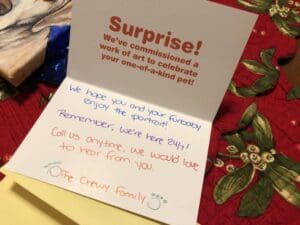
It just gets better. I was personally transfixed by the different-colored ink and didn't notice the printed message right away. "Surprise! We've commissioned a work of art to celebrate your one-of-a-kind pet!" It didn't register what that could've meant. We just dig deeper into the envelope to discover what the item was in the tissue paper. Everything about the presentation made the contents feel like a gift. More than a gift, this had all the elements. The blue foil packaging... and, we could imagine the giver skillfully writing the message on the card. There was the heart drawn next to my wife's first name. And, what about this "work of art?"
Think about what it's like to receive a gift. If you're like me, you start out delighted that someone cares. First, you'll read the card. There's anticipation mixed with curiosity and excitement. I always pause a moment before charging in to tear off the wrapping. It's a great feeling and I was captivated. This wasn't even my gift, but my wife let me open it anyway. I was also mesmerized by the absolute genius of this experience as a marketing campaign. I pride myself on some pretty imaginative ways of building relationships in business, but what Chewy did was so much more than marketing. And, we still didn't know what the gift was...

When we finally did tear into the paper, what we found was a hand-painted portrait of Murphy. I suppose it is possible our Murphy portrait was pulled from a stack of "yellow lab" portraits, but neither of us believes that to be the case. Our painting of Murphy looks exactly like the photograph of Murphy that we uploaded when my wife created her Chewy customer profile. So, here we are looking at our Murphy immortalized in canvas just before what might be his last Christmas. At that point it's no longer marketing. I know all about the tools--CRM, consumer segments, purchase history, printing... My wife and I stood in our kitchen holding a canvas portrait of a beloved family member we know may not be with us the same time next year.
We, as business owners, are always looking for an edge. We need to. It's a dog-eat-dog (Ha!) world out there, and standing out is hard. But, in finding that competitive advantage, there is a tendency to focus on ourselves. You see it in marketing messages all the time. "We're the number one this" or the "largest that." "We've been in business for X years." "We make the best..." We think this way because these are the things that make us great at what we do. But, that's not what or why people buy. People prefer to do business with people. More than that, they choose businesses with people they know care about them. Your customers feel special when you know their name. They feel even more special when you or someone on your staff goes the extra mile to make them feel important is individuals. It's not the gift. It's the context and the experience that matter most. Chewy won me, along with probably thousands of other pet owners like me. Chewy proved that being big and on the Internet doesn't have to be impersonal. Chewy gave my family a thoughtful gift at the perfect time. That's hard to do when you live with the person. It's incredible for a company that sells dog food over the Internet.
 Who is Ross Simmonds?
Who is Ross Simmonds?When selecting an internet marketer to be the subject of this weekly blog, we look for somebody who is making an impact in the IM industry. Ross is the perfect example of somebody who has become an IM and B2B thought leader. Ross is a B2B specialist with expertise is content marketing, social media, and storytelling. He has a passion for, in his own words, "technology, the future, good people, good coffee, and storytelling". Along with this he is an experienced entrepreneur. Ross owns a variety of businesses and brands that aim to help his fellow marketers, strategists, and entrepreneurs.
Ross is accomplished in many facets of the business world. To start, he's a B2B and content marketing expert. Ross has worked with businesses ranging from startups to Fortune 500 brands to increase their brand awareness and ROI. As Ross puts it. "You can't add fans & followers to the balance sheet. That's a reality. But for many agencies & B2B professionals, that's where the goalpost are and it's exactly why many struggle to see ROI." Ross uses his knowledge of the marketing process to help brands reach their ROI goals using content marketing. Along with his hands on work with brands, Ross wrote Stand Out: The Content Guide for Entrepreneurs. This book is Ross's ultimate guide to understanding the 'Why' behind content marketing.
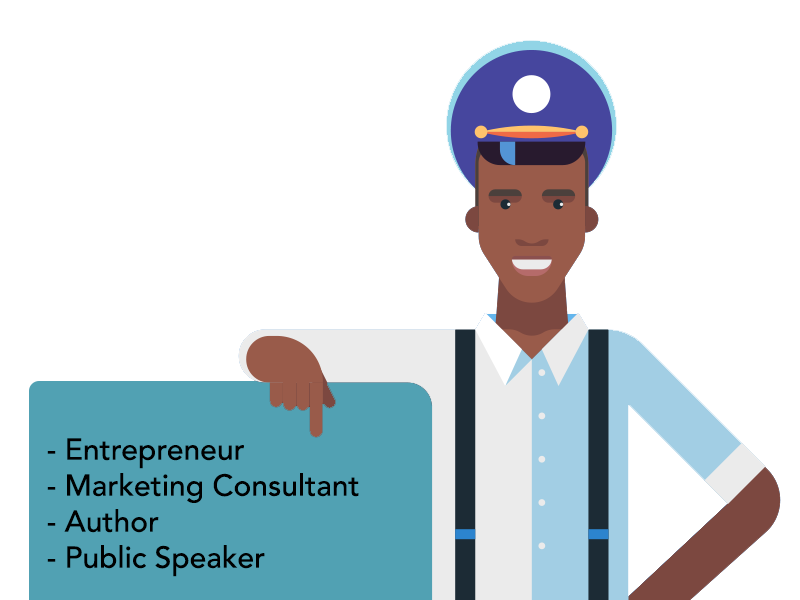
Ross works with other brands, but he also builds his own. As the founder of various companies, Ross has applied all of his B2B and content marketing knowledge to his own brands to build them into successes. He is the founder of Hustle & Grind, an eCommerce store specifically geared toward entrepreneurs, as well as other brands. Ross exemplifies the forward thinking content marketer that we, here at OCG, aim to bring onto our team. For more information on Ross Simmonds, you can visit his website and learn even more about what he's working on.
 Internet Marketing Background
Internet Marketing BackgroundAuthor of 13 books and presenter of over 50 keynote speeches a year, it’s no wonder that Guy Kawasaki is our internet marketer of the week. A venture capitalist, entrepreneur and advisor to Google among many other titles, Guy has worked with clients including Nike, Audi, Apple and Microsoft. But what sets Guy apart is his enthusiasm for innovation and entrepreneurship.
A marketing icon, Guy Kawasaki spent much of his early career learning how to sell. After he graduated from Stanford University with a BA in psychology, he enrolled in the MBA program at UCLA. While there, he worked for a fine-jewelry manufacturer, which helped him learn the principles of selling. Later, he took a job at Apple as a “chief evangelist” – a position that required him to “maintain and rejuvenate the Macintosh cult.” Since then, he has worn many hats, including advisor, writer and speaker.
I first became aware of Guy Kawasaki after being given his book The Art of Social Media in one of my university classes. As any college student, I quickly scanned through the book, wondering if it was worth my time. But I quickly realized that this stood out against the towering pile of textbooks we were expected to read. It offered immediate and tangible value. Guy capitalizes on the idea that positioning and branding come down to what the consumer decides, not what you decide. As marketers, we do our best to communicate to the world that our services and products are unique and valuable. But we must remember to continue to innovate, to look out for the next curve, and to roll with the decisions of our consumers. At OCG Creative, innovation is in each of our practices. From creating content strategies, to web development and lead generation – innovation is defined in each thought, definition and creation. For more information on Guy Kawasaki or to view his speech on innovation, visit him at guykawasaki.com.
Let me begin with a story. We have a client that went through half a dozen Internet marketing agencies prior to working with us. Those agencies did all the standard stuff: social media, PPC, landing pages, SEO… you name it. In every case, the agency added to the costs, but failed to make even a tiny impact on sales. Given that history, it is surprising that we are able to tell this story. Even as we were signing contracts, the client told me point blank that he didn’t believe our experience would be any different that what he’d been through with other marketing agencies. Fast forward a year… In about 12 months, we managed to place about 150 keywords on page 1 in Google. Those, by the way, are just the ones we’re tracking. There are probably another 300-400 top performing, related keywords that we don’t track. I’ll save an explanation of that for another article. Now, with hundreds of page one (most in the top 3) keyword rankings, you might expect tens of thousands of new visitors to the website. In reality, it’s closer to 4,000 per month. Big deal, right? Seems like a lot of work for 4,000 visits. Maybe, but here’s what those 4,000 new visitors mean to our client. From their own numbers, website form fills alone have lead to a little over $550,000 in revenue so far this year (FY17, as of August 1st.). Including web generated phone calls pushes YTD web-generated revenue close to a $million. Here’s the thing. For that $million in revenue, the client pays nothing to Google, and very little to the agency. The obvious question—What did we do differently? How is it that OCG Creative was able to tack on an extra million dollars in top-line revenue, after all the other agencies failed? The answer: Keyword selection. Well, keyword selection, coupled with being very good at SEO. Of course, you also have to provide your website visitors with what they were looking for when they decided to click, but it starts with optimal keyword selection.
There are three primary factors to keep in mind when selecting keywords for SEO. Lets examine them. User intent: A good way to look at this is to ask, what kind of problem is the searcher trying to resolve? When asked, clients typically suggest keywords (key-phrases) that are very broad. In SEO terms, we call them “short tail” phrases. An example of that would be “school supplies.” Short tail phrases tend to have the highest search volumes. In fact, 60,500 people search for “school supplies” every month. Compare that with “minecraft school supplies”, which receives about 720 searches per month. That’s just 1.19% of the search volume when you take away the word “minecraft.” It’s what we call a “long tail” keyword or key-phrase, and a virtual guaranteed better performer than “school supplies” by itself. The problem with short tail phrases is that they are nearly impossible to match to the problem your website visitor is trying to resolve. “School supplies” can be anything from soap for the nurses office to copy paper. The individual looking for “minecraft school supplies” probably has a 10 year old boy that’s into minecraft. (That’s a video game for those of you without a 10 year old boy.) The problem the searcher has is her kid wants minecraft themed stuff for school. (We can safely assume it’s a mom, because dad would try to make him get by with last year’s supplies. Let’s hope those karate lessons paid off, because any kid rolling into 5th grade with his 4th grade pencil box is the guaranteed object of ridicule.) The point is, regardless of the tiny relative search volume, “minecraft school supplies” is almost certain to make a sale. That very same mom conducting an initial search for “school supplies” is going to forced to keep searching. To further that point, we can generally assume about half of people searching for any given phrase will click on a result. Roughly a third of those will click on the top result. Number 2 gets about 20%, and #3, maybe 12% to %15. That works out to 120 website visits if your site is number one in the SERP (search engine results page). A highly targeted phrase is also going to have a high conversion rate. I’ve seen conversion rates as high as 70% for some keywords! Let’s aim lower, 25%, which would lead to 30 visitors making a purchase. To make that a little more digestible, I’ll break it down. Search volume, “minecraft school supplies”: 720 Searchers that clicked: 360 Click share for #1 in SERP: 33%, for 120 website visits Conversion rate: 25%, for 30 sales Let’s say the average sale is $50. That’s $1,500 per month in sales from a single keyword. Annualized, that’s $18,000 per year from one keyword! If you can identify 100 key-phrases like that one, similar numbers will produce $1.8M in annual revenue. It doesn’t even have to be 100 products. There might be 20 or more keywords different searchers use to find the same item. Since each searcher is a unique individual, the result is cumulative.
Shift your thinking from broad-match, high volume phrases, to long-tail phrases, highly focused on user intent. These are far easier to optimize for rankings, and will provide a directly measurable ROI. When selecting keywords, have a specific customer in mind that will take a predictable action. Know what problem the searcher is trying to resolve when searching that phrase, and provide the solution. Finally, set expectations for every keyword you choose to optimize. At minimum, include your anticipated click volume, conversion rate and average sale for each, and track them monthly. By planning your SEO efforts around specific keywords, selected based on user intent, you’ll be able to forecast their ROI. You’ll find it easier to achieve top rankings, and get a massive jump on your competitors.
 Tim Ash
Tim Ash Beginning now, we are introducing a weekly post recognizing top Internet marketers for their contributions. Our goal is to help business owners, marketing managers and others gain a broader understanding of the marketing landscape as it exists today.
Beginning now, we are introducing a weekly post recognizing top Internet marketers for their contributions. Our goal is to help business owners, marketing managers and others gain a broader understanding of the marketing landscape as it exists today.
These are the thinkers and pioneers in online marketing. They’re the people we pay attention to and learn from, while we develop cutting edge technologies of our own. Hopefully, in learning a bit about them, you’ll be inspired to take your own marketing efforts to ever greater heights.
I first learned of Tim Ash in 2007 when I read his book, Landing Page Optimization. By then, I already had several years of digital marketing experience behind me—especially SEO and conditional messaging, and sales-pipeline kinds of activities.
In the 2-3 years prior, I had begun formulating my own ideas about how marketing, especially online, was more of a statistical exercise than an artistic one. It was Tim Ash’s book that solidified my thinking, and gave words to what had previously been vague ideas and thoughts.
Even today, I recommend Landing Page Optimization to all of our newly hired Internet Marketers at OCG. Around here, Landing Page Optimization is referred to simply as “the book.” Save for the expected evolutions in available technologies, “the book” is a relevant today as it was in 2007.
Tim Ash is the President & CEO of a company called Site Tuners, a CRO (conversion rate optimization) firm that works with large organizations to ensure the highest possible ROI for their online efforts.
His Ph.D. studies were in Neural Networks and A.I., and he has a Master’s degree in computer science…. So, enough said about qualifications.
In many ways, we build and utilize landing pages the way we do today, because of the effort of Tim Ash back in the 1990s. I was an Internet Marketer at that time, working with some of the very first companies engaged in this new concept, e-commerce. That was before Google, and the search leaders were companies like HotBot, Inktomi and Ask Jeeves!
To imagine someone like Tim, with the foresight to analyze consumer behavior at a time where we were just focused on getting our SSL connections to work is amazing to me. It’s also humbling.
So, thank you, Mr. Ash. You’re an inspiration to me, and a great resource for our company.
If you’d like to learn more about Tim Ash, visit http://sitetuners.com/about/management/tim-ash/.
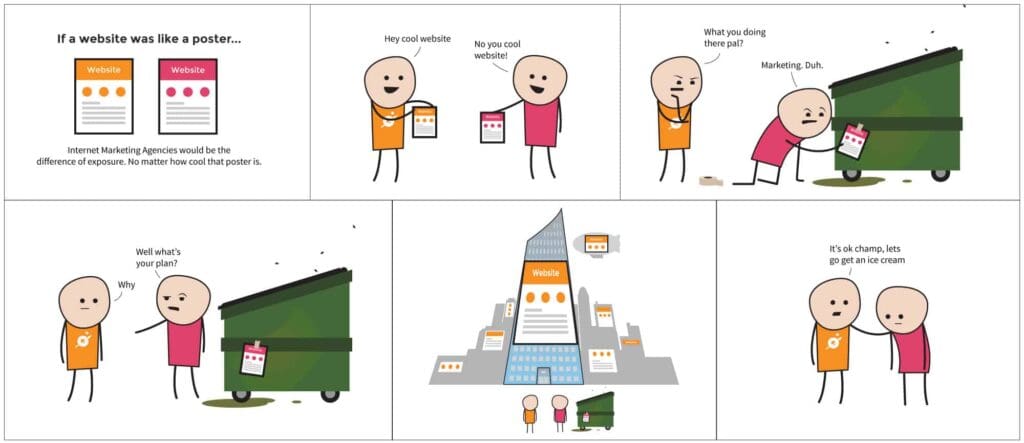
Creativity reigns supreme right? It is common knowledge that only the coolest websites get top exposure. Part of me, as a web designer, hopes this would be true. However, creative web design only takes a business so far. Ultimately, there are thousands of terribly designed websites that get more traffic than award-winners. If you want your website to work for you beyond a cocktail party talking point, then you need to know that Web Design is a part of Internet Marketing and not the same thing.
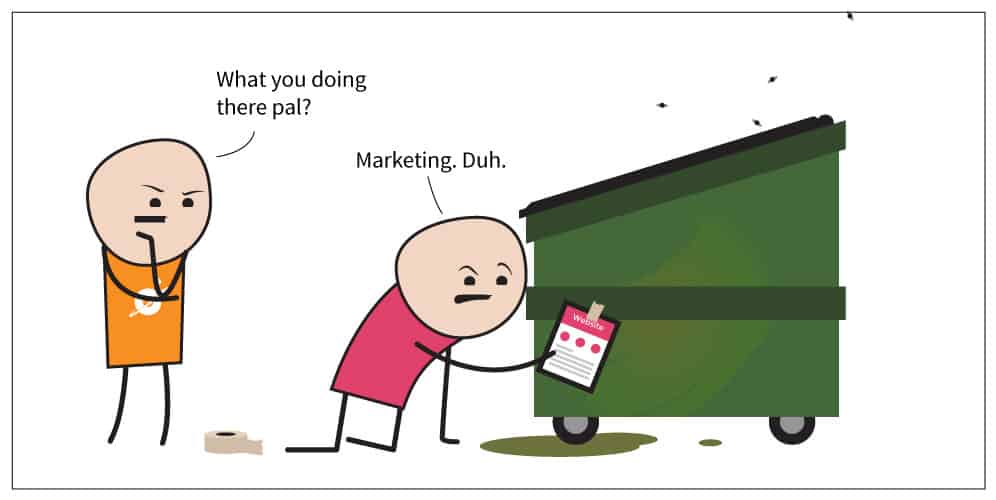
As cleverly explained by the cartoon, you can have the most creative and interesting website in the world, but if you market it horribly, then not many people will see it and you won’t get a very good return on your investment. OCG Creative’s team of dedicated and nerdy Reno web designers and developers work hard to produce these award winning sites. We have done this for numerous clients for many years. Part of the creative web design also involves the user’s experience with the website, which is why an analogy of a website being a poster is only part-true. In reality, a website is a fluid document – it changes with input from the user and looks different on different devices. OCG works to build the coolest website imaginable for our clients, but we know at the end of the day that it is essential to market it correctly, and websites should never stop when the design is completed.
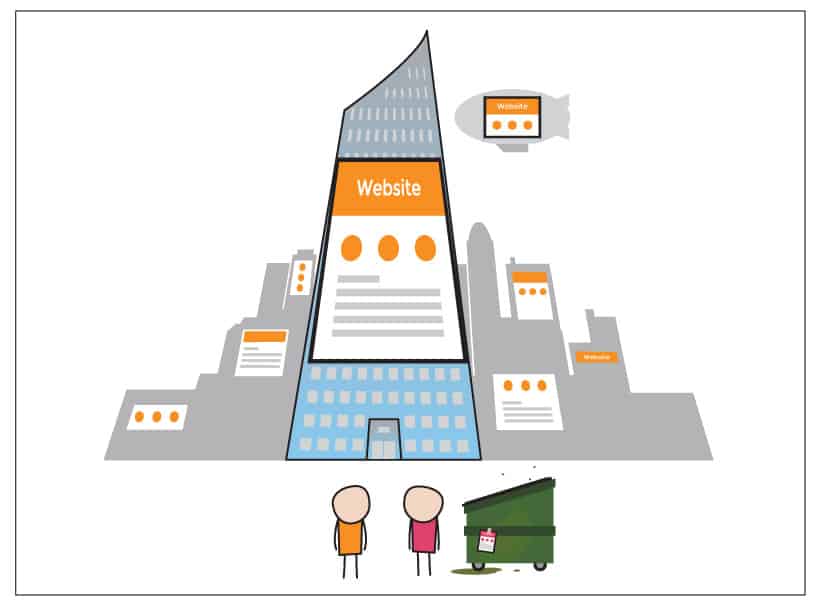
As a secret confession, I used to wonder this question all the time. There are plenty of online tools to build a website, and before I became a web designer, I even built my own portfolio using one of these tools. The issue with all of them… they’re awful. Even discounting the fact that all of them stop at the end of web design, the web design itself is clunky, confusing, and very limiting. I didn’t realize this until I experienced it first hand. A website should never stop at the end of creative web design. Instead, it should be a rocket-powered branding piece pushing the client forward to more exposure and spurring the start of a comprehensive effort to convert website visits into leads. OCG custom designs each website so it is beautiful and branded, but most importantly, they are scalable and sturdy for expansion in traffic and tailored to convert site visitors into customers.
After website design is completed, many people stop and never touch it again. It’s similar to making a cool poster and then never posting it anywhere. Why? Internet marketing takes effort, DIY site builders don’t have the resources to market each site created and the sites themselves are cluttered and reject efforts to market them. A lot of this is due to lack of on-site SEO support in addition to other elements such as effective landing pages and lack of Conversion Rate Optimization. It is much easier to stop after finishing the web design part.
The point is, OCG Creative is a dedicated and experienced Reno web design and internet marketing agency that has the resources. Websites should be built to be optimized for internet marketing. The issue with DIY site builders, is the website's inability to integrate with a meaningful and comprehensive marketing campaign for individual clients. This is because DIY sites purposefully exclude any means of integrating with an internet marketing plan, it is simply too much effort for DIY site builders to accommodate these features. Internet marketing takes time and a sturdy website foundation specifically built for internet marketing. Additionally DIY site builders don't want to manage campaigns because they take time and constant tuning. Hard work with SEO, Landing Pages, CRO, and other services, take time to gain traction. OCG maintains these campaigns, constantly tailoring our client’s Internet Marketing plans to coincide with optimal conversions including tracking page visits and valued keywords to get them ranking higher. You can’t get that level of detailed attention with do-it-yourself websites. It takes significant time, specialized data collection, and informed decisions to be implemented after data collection to market a website correctly.
If you’re not sure where to go from here knowing all of this or if you still think an awesome looking website is the most important thing for you or your business, give us a call or browse our other topics. We’ve been doing this for a while and know the internet marketing world front and back.
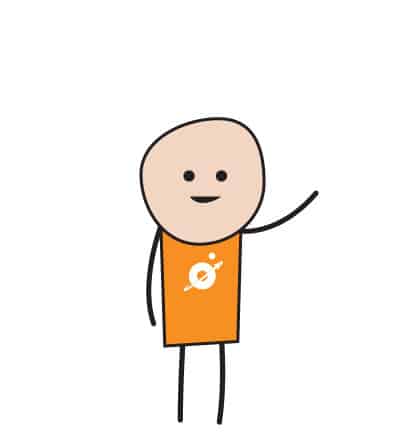
In Part I of this article, we explored primary website performance metrics and ways to ensure your data isn't influenced by scumbag spammers. Now that you're looking at unbiased numbers, let's explore ways to make sure your efforts align with the goals you have for your business.
To get there, it is worthwhile to reexamine your business goals and make an assessment about what matters most. It's easy to set broad goals like "get more sales," or arbitrary goals that have no basis in history or reality. An example of that might be a 100,000 monthly visitors to a new website, growing organically from zero.
For a goal to be valuable, it needs to specific, measurable, achievable, realistic and time-bound. You may recognize that as the formula for a SMART goal. There's lots of discussion about SMART goals in business school and around the web. Measured this way, you can see that my first example, "get more sales" isn't specific. The second, 100,000 monthly organic visits, probably isn't realistic.
A brand new website, on a new domain with all new content is going to have very different goals than a website that is already competitive. At this stage, your goal should be to get everything right, and lay a foundation to become truly competitive as your website gains traction.
At this point, traffic and visitor goals are far less valuable than those related search engines. Setting aside PPC (AdWords, etc.), if your website is genuinely new, your goals should center around what you can control.
1) Website content. Most owners of new websites get completely wrapped up in the design. In reality, the website design is secondary to the writing. Most of the time, the best way to improve a website's design is to take half of it out, but that's a topic for another day.
Online, it's your writing that brings new business. In the beginning, your website content is the one thing you have 100% control over. It's also the most important factor related to search engine rankings. So, if you are not a good writer, you have two options—either hire a good writer, or become one.
Website content goal: Write and publish a greater volume of better, more complete, compelling and interesting website content than your strongest competitor.
To make your website content goal a SMART goal, make it tangible and set dates.
S = Specific: List your top competitor's webpages. Paste each page into a word processor to get a word count. Jot down a list of keywords used on the page and note the number of times each one was used. Make an additional note of any text links and where they go, as well as all levels of headings used throughout the website. Do this for EVERY PAGE, even if it takes a week or more.
M = Measurable: Having quantified the the website details of your toughest competitor, next you'll need to decide what to measure. In this case, you don't need anything more than a word processor. When you have more pages, with better focused, better written copy, using the same keyword density, plus at least as many links, you're good… for now. Measuring these items is as simple as counting.
A = Achievable: This goal is achievable as long as you, or someone you hire has the skill to write meaningful website content. It must follow the "rules" you outlined by assessing your competitor's website. As long as you know what to write, and have the ability to do it, this goal is achievable.
R = Realistic: If you are writing your own website content, the only thing you need to assess is whether or not you will actually do it. We, as business owners, are an industrious lot. We do things ourselves and tend to take on a lot. You are probably very busy running your company. Is writing and editing what could be tens of thousands of words really realistic? If not, you may want to hire a writer.
T = Time-bound: So far, so good, but it's not a goal until you set a date to finish. Some people can write 600 words an hour. Others take 600 hours to write a page. Set your deadline based on your business objective, balanced with a reasonable assessment of what you are capable of. There is an "opportunity cost" for not having your website published and ready to compete. Don't let excuses or your own busy schedule set you back. If it looks like plan A is going to put you beyond your deadline, have a plan B ready to go. [coach voice] This is business, people, so let's make it happen.
2) Unique Titles and Descriptions. This is SEO 101 kind of stuff—something I like to describe as the Onsite SEO Top 5. Our content goal covered the first three items; keyword density, headings and anchor text (the actually words used for links). That leaves page titles and descriptions.
HTML TITLE Tags: The page title is created by using a special tag in the head of the html document used to create the page. The browser loads this page and displays your title in the browser tab. More importantly, search engines display your title as the link in the SERP (search engine results page).
Google, Bing, Yahoo! and all the others use this title as a primary means for determining what the page is about. Therefore, it makes sense that these should include your target keywords. Making sure they do should be standard practice. Your titles should match the content of the page, and also be unique. Don't use the same title for every page on your website.
Meta Descriptions: The head of your html document should also contain a meta description. There is considerable debate over the direct value of the description relative to SEO. Nevertheless, you should ALWAYS include a unique description on every page of your website.
Like the page title, the meta description you write will be displayed in search results. This is the descriptive text just below the line containing the webpage URL.
You should always use keywords in your meta description, even if you don't believe they will have an impact on rankings in Google. This is because a) searchers will often read the description when deciding whether or not to click the link, and b) Google is not the only search engine. (Though it does seem like it is.)
Make unique titles and descriptions part of your content goal. It's not as technical as it sounds. Many content management systems have built-in tools for including these. If you are one of the millions of WordPress users, a plugin like Yoast SEO will make your job easy. The challenge will be making them unique and readable for humans, as well as search engine spiders.
I framed this as a content goal for new websites, but if you haven't already done so, you should make a similar assessment even if your site has been online for time and is performing well. Website content forms the foundation of your online marketing strategy. It is vitally important that you keep your online content competitive and up to date.
The working word in that statement is competitive. With every passing day, the likelihood your competitor will hire a top SEO firm to crush you, increases. To combat that, you need to pay attention to what's happening around the Internet relative to your market or industry.
It is important to realize that without sufficient website content, nothing you can do will achieve a consistent, stable result. In nearly every case, websites that are thin on online content will suffer, not only in rankings, but with visitors seeking information.
Part III of this series will focus on taking your effective Internet marketing strategies to new heights. To do that, we'll put out nerd hats on and dig deeper into the data. In the mean time, feel free to email me (joe@ocgcreative.com) or comment below with your questions or comments.
This article is heard toward small to medium sized businesses in moderately competitive markets. However, the fundamentals of evaluating online marketing efforts are largely the same for any business. It is important to recognize that an effective internet marketing plan must take the competitive landscape into account. The following questions should help get you thinking about what you need to know as your online marketing efforts evolve.
The first two questions are perhaps the most important. Marketing sophistication and the level of effort devoted to effective Internet marketing will level the playing field in spite of virtually everything else.
I’ll begin with what I call the primary metrics. These are the data shown on the first page when you log into Google Analytics. Here’s what they are and what mean.
All of this information is historical in nature, and only provides totals and averages. It is helpful for identifying trends, but to understand what’s happening on your website, you need to dig deeper.
From the beginning you need to know the information you rely on is valid. The vast majority of websites I work with for the first time take everything fed to Google Analytics as legitimate. The truth is it’s probably not even close. Here are a few things that screw up your data.
Spambots: These are computer programs, often called robots, spiders, crawlers or some other name. Not all robots are bad, but spambots scour the web looking for any online form to fill out with bogus information. Their goal is to create links to crappy websites by them into the comments section of your blog or other publicly visible content.
They do this in a nefarious attempt build the number of inbound links (backlinks) to some website. Entire companies, mostly in Eastern Europe and China, are devoted to selling backlinks this way. It’s obnoxious and doesn’t work, but comment spam is everywhere.
Tip: You should always moderate blog comments before allowing them to be published on your website. At the very least moderate those that include links.
What sucks is each attempt is reflected as as a visit. Usually, visits from spambots will have a bounce rate of 100% and a session duration of 00:00. They badly skew your data, and will often overwhelm legitimate traffic. As an example, a typical website with 1000 legitimate visits might have a bounce rate of 35%.
Add 500 visits from scumbag spambots and your traffic will be reflected as 1500 sessions with a bounce rate of 56.6%. Without the phony data from the spambots, the top level data looks pretty good. But, if you believe the numbers that include the spambot data, you’re likely to try to correct a problem that doesn’t exist.
Referral Spam: These are jerks who bombard your website from a URL they want you to visit. The idea is that if you see a sharp spike in traffic, you’ll want to investigate the source. Once you know where the traffic is coming from, it is very natural to want to check it out.
What’s actually happening is your are being tricked into visiting websites you wouldn’t know about otherwise. Beyond that, these referral spammers screw up your data much like the spambots do. Your traffic will be artificially high, and your bounce rate, time on site and pages per visit will all be wrong.
I’ll touch on filtering Google Analytics in a minute, so here’s a short list of URLs I filter out always.
There are more, but these eight routinely account for 60% to 70% of website visits. Many times I’ve seen referral spam account for virtually all of a website’s traffic.
My clients often think they have high bounce rates and low session durations, but plenty of traffic. So, they pull their hair out tweaking pages and moving content, but it makes no difference. Here’s a real-world example of what’s happening:
Unfiltered Website Traffic Data:
Sessions: 1127
Avg. Session Duration: 00:00:06
Bounce Rate: 88.14%
Filtered Website Traffic Data:
Sessions: 188
Avg. Session Duration: 00:01:54
Bounce Rate: 39.38%
In this example, the client came to me to solve a bounce rate / session duration problem, when in fact, he suffered from weak traffic volume. It was the exact opposite of what he believed. It’s maddening and disheartening, but once we were able to deal with real numbers, we could work on the right things.
Hacking Attempts: Depending on the type of attack, hacking attempts will also skew your data. It should be obvious by now that bogus visits tend to push sessions up and session durations down.
Brute force attacks sometimes result in legitimate traffic not even getting through. What’s happening is the hacker has a network of corrupted computers trying to guess passwords or take advantage of a known exploit.
In some cases, they’ll just hammer your website with thousands of visits a second so no legitimate traffic can get through. I won’t bother with the details right now, but recognize that hacking attempts screw up your data.
It should be obvious, but you can’t ignore hacking attempts. Data and traffic issues aside, given time, a hacker will get through. That never ends well, so if you suspect you are being attacked, call or email us and we’ll help you deal with it.
Internal Traffic: A website that is being actively worked on will skew your number in the opposite direction. Web designers and content curators often spend hours on pages and hop through the website testing user interface changes.
Early on, that may be your only traffic. It might warm your heart to think people are visiting every page on your website an hour and a half at a time, but it’s not really real. Again, filtering is the answer. In this case, you would filter the IP addresses of anyone that actively works on your website.
Also, if your website is WordPress, you can use a plugin to disable Google Analytics tracking code for certain types of users when they’re logged in. If they aren’t logged in, it’ll still mess with your data though, so it is best to filter by IP.
Job Searches: Obviously, legitimate visitors to your careers page are desirable. I mention them here because job searchers are most likely not buying anything. It really depends on your business and the nature of the visit.
It may be that the website visitor arrived as a genuine potential customer. Then, decided to explore career opportunities. In this case, the visit certainly has conversion potential. In our agency, that’s unlikely, so unless we want to assess our recruiting efforts, we filter those visits into another view.
Next, I'll provide details about keyword tracking and tools you can use to evaluate whether or not you are executing an effective Internet marketing strategy. Drop me an email, and I'll be sure to let you know when "Effective Internet Marketing: Part II" is published.